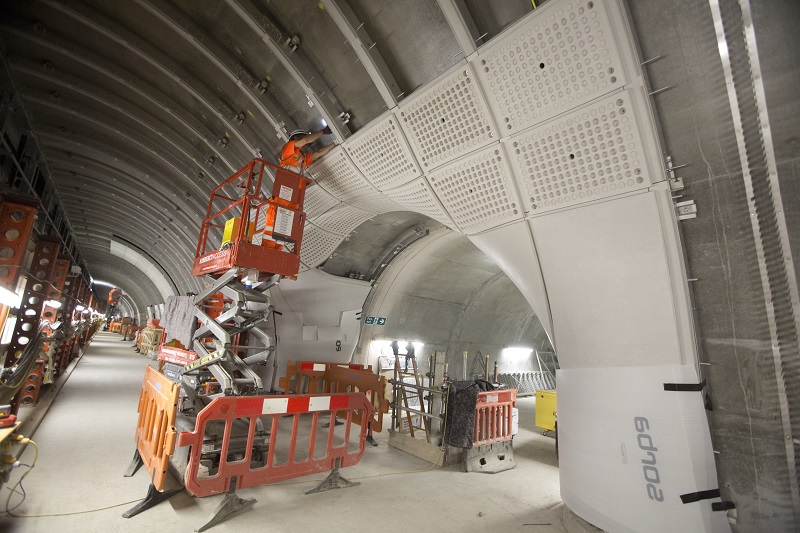CIC Economic and Policy Briefing 2017
Contents |
[edit] Introduction
On 21 February 2017, Designing Buildings Wiki attended the first CIC Economic and Policy Briefing of 2017. Chaired by Rt Hon. Nick Raynsford, the Construction Industry Council (CIC) briefings provide regular economic analyses, policy updates and comments on major commercial projects. The briefings bring together leading policy-makers, economists and senior industry players to discuss the key topics in an informal setting.
This briefing included an economic overview and forecast for construction, insight into illegal working in construction, and an update on the Crossrail 2 project.
[edit] Economic overview and forecast for the construction sector
James Hastings, Head of Construction Futures at Experian, began by explaining that in the aftermath of the EU referendum, growth forecasts took a big negative hit. Though there has been something of a bounce-back – to 1.3% as of January 2017 – most economic analysts are in agreement that Brexit will have a negative impact in the short term.
In terms of construction, he identified the following vulnerabilities, divided into positive, neutral and negative.
Positive:
- No Brexit-induced recession is predicted.
- Some very big infrastructure projects are in the pipeline, although this is predicated on there being no slippage on HS2, Hinkley Point and Wlyfa Nuclear Power Station.
- Private housing growth continues.
Neutral:
- Abandonment of 2020 fiscal target may mean a little more money for the public capital projects.
- A slowdown in commercial construction growth rather than outright decline.
Negative:
- Higher export growth is unlikely to mitigate a slowdown in domestic demand for manufacturing.
- The retail construction sector continues to struggle.
Hastings suggested the government is currently targeting the wrong areas with their Housing white paper. He said they should be focusing on building “true social housing for those who have no prospect of getting on the property ladder”, regardless of Help to Buy and various other schemes. The only way to solve the housing crisis, he said, was a “significant uplift in social housing”.
[edit] Illegal migrant workers
Christopher Tilley, Illegal Working Threat Lead – Deputy Director at the Home Office, gave a briefing on the importance of protecting businesses and supply chains from illegal working.
He started by explaining that access to the labour market is a key pull factor for illegal migration, and emphasised that the exploitation of illegal workers allows unscrupulous employers to undercut competition.
Tilley gave the unconfirmed estimate that there were between 500,000 and 900,000 illegal workers in UK construction; predominantly working in logistics, concreting, facility services, and such like.
He highlighted the Immigration Act 2016, which included the new offence of illegal working, and also made it possible to prosecute rogue landlords and agents who repeatedly fail to carry out right to rent checks.
The Home Office branch of Immigration Enforcement have the power to close sites for 48 hours and issue compliance orders for up to 12 months. They can also issue civil penalties of up to £20,000 per illegal worker.
According to Tilley, there is widespread use of fraudulent/counterfeit documents in construction, in particular, fraudulently obtained Construction Skills Certification Scheme (CSCS) cards. Contractors are failing to carry out Baseline Personnel Security Standard (BPSS) background checks in full, and often accept documentation at face value.
He identified several measures that contractors can implement to combat illegal working:
- Consider voluntary codes of practice (such as the Modern Slavery Toolkit, recently published by CIOB).
- Due diligence checks prior to awarding contracts.
- Right to Work clauses in contracts.
- Identity checks for agency staff.
- Document scanning technology.
- Proper training for HR and recruitment staff.
- Online support such as Gov.uk, PRADO and Keesing.
[edit] Update on Crossrail 2
Dr Andrew Neather, Strategic Advisor and Communications at Transport for London, provided an update on the progress of the Crossrail 2 project.
Neather began by identifying the recent milestones:
- March 2016: National Infrastructure Commission (NIC) gave their strong backing to the project and recommended it to be ‘taken forward as a priority’.
- May 2016: Sadiq Khan was elected Mayor of London, with a commitment to take the project forward.
- October 2015 to January 2016: A large public consultation attracted almost 26,000 responses.
- Summer 2016: A report was published on the response to issues raised.
He explained that the Revised Business Case for the project will be submitted in March 2017, with the following changes:
- A budget reducing costs by £4 billion.
- A more detailed funding package.
- Evidence showing conclusively why Crossrail 2 is the right project for London.
- A plan to deliver the additional 200,000 homes Crossrail 2 will support.
The capital costs are now forecast at £31.2 billion, using 2014 prices and including a 66% ‘optimism bias’, which Neather claimed was tougher than that applied to HS2. The biggest cost is the stations (£9bn) and on-network works (£5.5bn).
The funding share has been agreed as follows:
- 44% government funding.
- 56% London funding.
The following milestones are projected for the future:
- Summer 2017: Public consultation on Revised Business Case.
- 2019: Submit consent powers application.
- 2022: Start construction.
- 2032/33: First Crossrail 2 service.
[edit] Related articles on Designing Buildings Wiki
Featured articles and news
Infrastructure that connect the physical and digital domains.
Harnessing robotics and AI in challenging environments
The key to nuclear decommissioning and fusion engineering.
BSRIA announces Lisa Ashworth as new CEO
Tasked with furthering BSRIA’s impressive growth ambitions.
Public buildings get half a million energy efficiency boost
£557 million to switch to cleaner heating and save on energy.
CIOB launches pre-election manifesto
Outlining potential future policies for the next government.
Grenfell Tower Inquiry announcement
Phase 2 hearings come to a close and the final report due in September.
Progress from Parts L, F and O: A whitepaper, one year on.
A replicated study to understand the opinion of practitioners.
ECA announces new president 2024
Electrical engineer and business leader Stuart Smith.
A distinct type of countryside that should be celebrated.
Should Part O be extended to existing buildings?
EAC brands heatwave adaptation a missed opportunity.
Definition of Statutory in workplace and facilities management
Established by IWFM, BESA, CIBSE and BSRIA.
Tackling the transition from traditional heating systems
59% lack the necessary information and confidence to switch.
The general election and the construction industry
As PM, Rishi Sunak announces July 4 date for an election.
Eco apprenticeships continue help grow green workforce
A year after being recognised at the King's coronation.
Permitted development rights for agricultural buildings
The changes coming into effect as of May 21, 2024.
























Comments